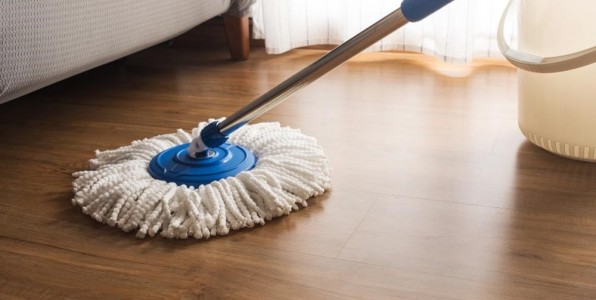Wood Flooring Maintenance: A Quick Guide

Wood Flooring Maintenance: A Quick Guide
The post Wood Flooring Maintenance: A Quick Guide appeared first on UK Construction Blog.
Wood flooring adds a touch of elegance and warmth to any space. With its natural charm and rich texture, it can transform a room into a cosy haven. A well-maintained wooden floor can also dramatically enhance the aesthetic appeal of a space, seamlessly merging comfort with luxury. But as enchanting as wood flooring is, it’s not self-sustaining. It requires care to maintain its lustre over the years.
This guide aims to equip homeowners with essential maintenance tips to ensure that wood flooring stays pristine for several years.
The Basics Of Wood Flooring Care
Before diving deep into the intricacies of wood floor maintenance, it’s essential to understand the nature of wood. Wood is a natural material; hence, it can react to environmental changes such as moisture and temperature fluctuations. Also, although hardy, it can be susceptible to scratches, dents, and stains. By understanding these characteristics, homeowners can lay the groundwork for effective maintenance, ensuring their flooring’s longevity and sustained elegance.
For those who’ve invested in high-quality flooring or are contemplating a new installation, reputable sources like woodenfloorsuk.com provide invaluable insights into the world of wood flooring and how to maintain it. Remember, the key to longevity lies in routine maintenance combined with timely interventions.
Common Wood Flooring Maintenance Tasks To Remember
Once you grasp the basics, the next step is to familiarize yourself with routine maintenance tasks. These tasks are essential to prolong the life and beauty of wood flooring:
1. Regular Cleaning
One of the primary tasks in wood flooring care is regular cleaning. A regular cleaning routine can help remove dirt, dust, and grime and prevent them from building up and damaging the finish. With the cleaning aspect covered, let’s delve into preventive measures:
- Sweeping and Vacuuming: Routine surface cleaning is pivotal. Daily wear introduces dust, dirt, and microscopic debris that, when left unchecked, can cause minute scratches, diminishing the floor’s shine and smoothness. Hence, make sure to use a soft-bristled broom or a vacuum with a hardwood attachment when cleaning. This can ensure that debris is promptly removed.
- Damp Mopping: While sweeping takes care of dry debris, weekly damp mopping can ensure the removal of stubborn dirt and light stains, maintaining the floor’s pristine finish. In doing so, use a damp (not wet) mop with a mild wood floor cleaner. Excess moisture can damage the floors, so wring out the mop thoroughly.
With these cleaning methods, homeowners can protect their wood flooring from damage.
2. Observe Preventive Measures
Preventive measures are also necessary to keep the wood flooring in top shape. For example, it’s essential to place protective pads under furniture legs to reduce the risk of scratches and dents. Ensure these pads are cleaned regularly to prevent grit and debris from accumulating.
Moreover, use area rugs or runners in high-traffic areas to dramatically minimise wear. However, choose rugs without a rubber or vinyl backing, as they can trap moisture and damage the wood underneath.
Lastly, limit direct sunlight. Wooden floors can fade or discolour when exposed to direct sunlight for extended periods. Use blinds, shades, or curtains to minimise direct sunlight exposure.
3. Address Spills And Stains
Immediate attention is crucial when dealing with spills. Liquids can damage the finish of wood floors and even penetrate deeper, causing lasting damage. For instance, wipe water and other spills immediately using a soft, dry cloth. When it comes to sticky substances, gently scrape them off with a plastic scraper, then wipe with a damp cloth.
For homeowners who encounter stubborn stains, a mixture of baking soda and water can be used as a gentle abrasive. Make sure to rub the stain gently and wipe it clean.
4. Refinish And Do Deep CleaningÂ
Over time, the surface finish on wood floors can wear away. This can affect the appearance and expose it to potential damage. To keep the flooring in pristine condition, certain methods may be applied. For example, homeowners can conduct screening and re-coating to address superficial wear and ensure continued protection.
For floors that have faced years of wear, refinishing and sanding can help revive their inherent beauty, making them look and feel new.
5. Observe Proper Humidity And Temperature Control
Wood expands and contracts with changes in humidity and temperature. Thus, a stable environment is crucial to prevent warping, cupping, or gapping. For instance, it’s essential to maintain an ideal humidity range, which is approximately 40-60%. Consider using a humidifier or dehumidifier to achieve this range.
Additionally, maintain a temperature ranging approximately from 15-25°C (60-77°F) and avoid sudden temperature changes.
6. Be Mindful Of Chemicals
It’s tempting to use household cleaners on wood floors. However, many chemicals can damage the finish or the wood itself. For example, avoid ammonia-based cleaners, wax-based products, detergents, bleach, and abrasive cleaning agents. On the other hand, it’s highly recommended to use pH-neutral cleaners designed specifically for wood floors.
Conclusion
Maintaining wood flooring is a combination of regular cleaning, preventive measures, and occasional deep treatments. By keeping the information mentioned above in mind, wood floors can remain a stunning feature of a home for generations. Seasoned or newbie homeowners who invest time in understanding and implementing these practices can guarantee the longevity of their prized floors.

Comments are closed